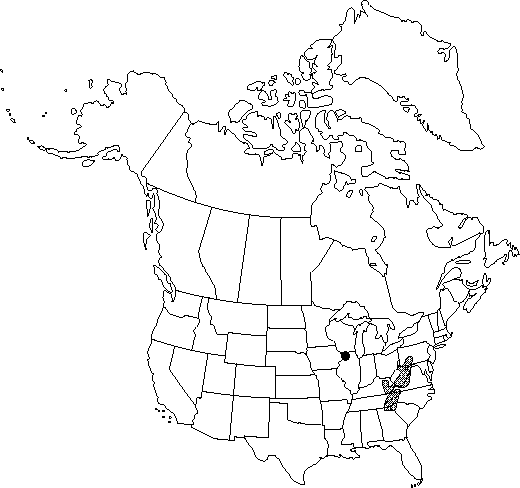Cimicifuga americana
Fl. Bor.-Amer. 1: 316. 1803.
Stems 60-250 cm, usually glabrous, rarely sparsely pubescent. Leaves: petiole rounded abaxially, 8-16 cm, broadly and shallowly grooved adaxially, glabrous, rarely with a few lax hairs in groove. Leaf blade (2-)3-ternately compound; leaflets 32-100; terminal leaflet of central segment ovate to oblong, incisely 3-lobed, 6-15 × 4-14 cm, with 3 veins arising basally, base cuneate to somewhat cordate, margins dentate to serrate, apex acute to acuminate, surfaces glabrous or glabrate; other leaflets 3-15 × 3-10 cm. Inflorescences ± lax panicles of 3-10 racemelike branches, 10-50 cm, densely short-pubescent and granular; bract 1, subtending pedicel, broadly triangular, acute, 1-3 mm; pedicel to 20 mm, granular, bracteoles present along most of pedicel, narrowly triangular, acute. Flowers: sepals 5, 3 outer white tinged red, 2 inner yellowish green; petals usually 2, rarely more, sessile, body yellowish with white lobes, ovate, 3-6 mm; nectary basal; stamens 40-70; filaments 6-10 mm; pistils 3-8, short-stipitate, body glabrous, stipe granular; style subulate, often curved; stigma minute, 0.2 mm wide. Follicles 2-4, stipitate, obovate, laterally compressed, 8-17 mm, membranous walled, glabrous. Seeds pale brown, lenticular, ca. 3.5 mm, covered with whitish, broad, lacerate scales but not apprearing cylindric.
Phenology: Flowering summer–fall (Aug–Oct).
Habitat: Moist, rich, rocky and boulder-strewn, wooded slopes and coves
Elevation: 300-2000 m
Distribution

Ga., Ill., Ky., Md., N.C., Pa., S.C., Tenn., Va., W.Va.
Discussion
Much confusion has developed over the name Cimicifuga cordifolia Pursh. Although F. Pursh (1814, vol. 2, pp. 372-373) considered it synonymous with C. americana, several other authors have variously misapplied the name C. cordifolia to C. racemosa and C. rubifolia.
Selected References
None.
